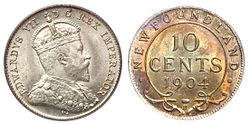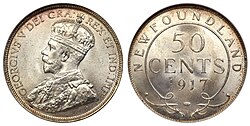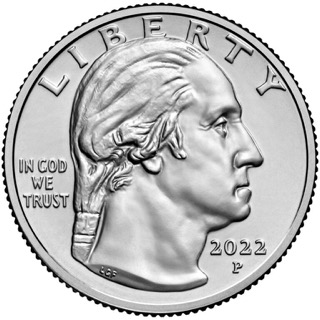
The quarter, formally known as the quarter dollar, is a denomination of currency in the United States valued at 25 cents, representing one-quarter of a dollar. Adorning its obverse is the profile of George Washington, while its reverse design has undergone frequent changes since 1998. Since its initial production in 1796, the quarter dollar has held a significant place in American numismatics, with consistent production since 1831.

The cent, the United States of America one-cent coin, often called the "penny", is a unit of currency equaling one one-hundredth of a United States of America dollar. It has been the lowest face-value physical unit of U.S. currency since the abolition of the half-cent in 1857. The first U.S. cent was produced in 1787, and the cent has been issued primarily as a copper or copper-plated coin throughout its history. Due to inflation, pennies have lost virtually all their purchasing power and are often viewed as an expensive burden to businesses, banks, government and the public in general.

The penny of Great Britain and the United Kingdom from 1714 to 1901, the period in which the House of Hanover reigned, saw the transformation of the penny from a little-used small silver coin to the bronze piece recognisable to modern-day Britons. All bear the portrait of the monarch on the obverse; copper and bronze pennies have a depiction of Britannia, the female personification of Britain, on the reverse.
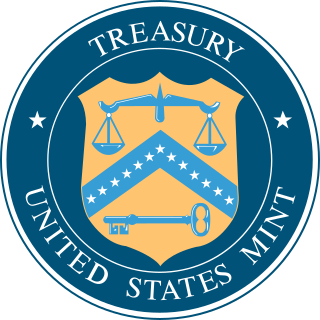
The United States Mint is a bureau of the Department of the Treasury responsible for producing coinage for the United States to conduct its trade and commerce, as well as controlling the movement of bullion. The U.S. Mint is one of two U.S. agencies that manufactures physical money. The other is the Bureau of Engraving and Printing, which prints paper currency. The first United States Mint was created in Philadelphia in 1792, and soon joined by other centers, whose coins were identified by their own mint marks. There are currently four active coin-producing mints: Philadelphia, Denver, San Francisco, and West Point.
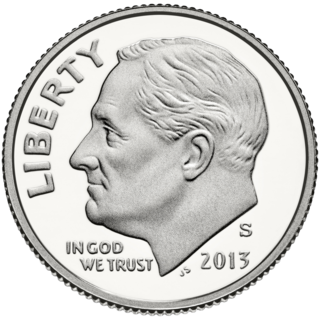
The dime, in United States usage, is a ten-cent coin, one tenth of a United States dollar, labeled formally as "one dime". The denomination was first authorized by the Coinage Act of 1792.

In Canada, a penny is an out-of-production coin worth one cent, or 1⁄100 of a dollar. According to the Royal Canadian Mint, the official term for the coin is the one-cent piece, but in practice the terms penny and cent predominate. Penny was likely readily adopted because the previous coinage in Canada was the British monetary system, where Canada used British pounds, shillings, and pence as coinage alongside U.S. decimal coins and Spanish milled dollars.
The British farthing was a British coin worth a quarter of an old penny. It ceased to be struck after 1956 and was demonetised from 1 January 1961.
This glossary of numismatics is a list of definitions of terms and concepts relevant to numismatics and coin collecting, as well as sub-fields and related disciplines, with concise explanations for the beginner or professional.
The coins of the South African pound were part of the physical form of South Africa's historical currency, the South African pound. Prior to the Union of 1910, various authorities issued their own pounds, some as independent entities. After the Union but before 1923, coins in circulation were mostly British, but the coins of Paul Kruger's South African Republic remained in circulation. In 1923, South Africa began to issue its own coins, adopting coins that were identical in size and value to those used in Great Britain: 12 pence (12d) = 1 shilling (1s), and 20s = 1 pound (£1). On 14 February 1961, the Union of South Africa adopted a decimal currency, replacing the pound with the Rand.
Upper Canada had a short history as a coin-issuing entity.
The coins of Canada are produced by the Royal Canadian Mint and denominated in Canadian dollars ($) and the subunit of dollars, cents (¢). An effigy of the reigning monarch always appears on the obverse of all coins. There are standard images which appear on the reverse, but there are also commemorative and numismatic issues with different images on the reverse.

The British halfpenny coin was worth 1/480th of a pound sterling. At first in its 700-year history it was made from silver, but as the value of silver increased the coin was made from base metals. It was finally abandoned in 1969 as part of the process of decimalising the British currency. "Halfpenny", colloquially written ha'penny, was pronounced HAY-pə-nee; "1 ½d" was spoken as a penny ha'penny or three ha'pence.
In 1847, the Kingdom of Hawaiʻi, under the reign of King Kamehaheha III, issued its first official coinage—a large one-cent copper penny—to alleviate the chronic shortage of small denomination coins circulating in the Hawaiian Islands. The next and last official coinage of the Hawaiian Islands was minted in 1883, by King Kalākaua I; however during the intervening period, the changing needs of the Hawaiian Islands were met by circulating private-issued tokens and the coins of the United States of America.

The shilling, informally called a "bob", was a type of silver coinage issued by the Commonwealth of Australia, that circulated prior to the decimalisation of Australian coinage. The Australian shilling was derived from the British pre-decimal sterling pound system and was first issued following the passing of the Australian Coinage Act 1909, which established Australia's first formal currency system. The shilling was issued as part of Australia's silver coinage, which included the two-shilling (florin), the sixpence and the threepence. The shilling was minted from 1910 until 1963. During this period there was one significant modification to the design of the Australian shilling, the change in its reverse design, which occurred in 1938 when the design was altered from the Australian coat of arms (1910–1936) to the visage of a Merino ram's head (1938–1963).

The Australian pre-decimal halfpenny coin, commonly known as a ha’penny, was the smallest denomination of the Australian Pound in circulation. It was a unit of currency that equalled half of a penny, 1/24 of a shilling, or 1/480 of a pound. The coin was made to be equivalent to the British halfpenny; its dimensions, composition and values were equivalent, and additionally, the two currencies were fixed at par.

The Prince Edward Island dollar was a unit of currency used in Prince Edward Island. The dollar replaced the Prince Edward Island pound in 1872 at a rate of 1 pound = 4.866 dollars. The dollar was subdivided into 100 cents.

The Lincoln cent is a one-cent coin that has been struck by the United States Mint since 1909. The obverse or heads side was designed by Victor David Brenner, as was the original reverse, depicting two stalks of wheat. The coin has seen several reverse, or tails, designs and now bears one by Lyndall Bass depicting a Union shield. All coins struck by the United States government with a value of 1⁄100 of a dollar are called cents because the United States has always minted coins using decimals. The penny nickname is a carryover from the coins struck in England, which went to decimals for coins in 1971.

The Newfoundland 2-dollar coin was issued in intermittent years between 1865 and 1888. It was the only circulation gold coin issued by a British colony. Although few coins were issued, it was broadly used in Newfoundland and eastern Canada. The coin became scarce in 1894 because of hoarding following the collapse of Newfoundland's banks and monetary system.
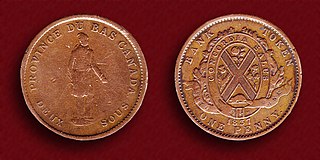
The Habitant token were a series of tokens that were created for use primarily within Lower Canada and were issued in 1837. Produced as a successor to the popular bouquet sous, these tokens depicted a Habitant on the obverse, a traditional depiction of a French-Canadian farmer in winter clothing, and the coat of arms for the City of Montreal on the reverse. The tokens were issued in both one penny/deux sous and half penny/un sou denominations by the leading commercial banks of Montreal. They were issued in large numbers and can be easily acquired by the modern collector, though some varieties are rare and command a premium.









